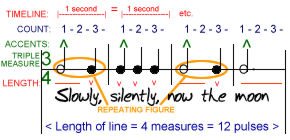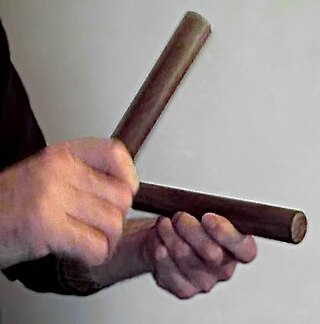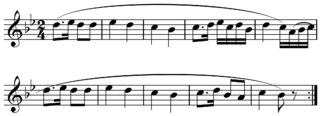Rhythm generally means a "movement marked by the regulated succession of strong and weak elements, or of opposite or different conditions". This general meaning of regular recurrence or pattern in time can apply to a wide variety of cyclical natural phenomena having a periodicity or frequency of anything from microseconds to several seconds ; to several minutes or hours, or, at the most extreme, even over many years.
In music, syncopation is a variety of rhythms played together to make a piece of music, making part or all of a tune or piece of music off-beat. More simply, syncopation is "a disturbance or interruption of the regular flow of rhythm": a "placement of rhythmic stresses or accents where they wouldn't normally occur". It is the correlation of at least two sets of time intervals.
A time signature is a convention in Western music notation that specifies how many note values of a particular type are contained in each measure (bar). The time signature indicates the meter of a musical movement at the bar level.

In music, metre or meter refers to regularly recurring patterns and accents such as bars and beats. Unlike rhythm, metric onsets are not necessarily sounded, but are nevertheless implied by the performer and expected by the listener.

The clave is a rhythmic pattern used as a tool for temporal organization in Brazilian and Cuban music. In Spanish, clave literally means key, clef, code, or keystone. It is present in a variety of genres such as Abakuá music, rumba, conga, son, mambo, salsa, songo, timba and Afro-Cuban jazz. The five-stroke clave pattern represents the structural core of many Cuban rhythms. The study of rhythmic methodology, especially in the context of Afro-Cuban music, and how it influences the mood of a piece is known as clave theory.

In music and music theory, the beat is the basic unit of time, the pulse, of the mensural level. The beat is often defined as the rhythm listeners would tap their toes to when listening to a piece of music, or the numbers a musician counts while performing, though in practice this may be technically incorrect. In popular use, beat can refer to a variety of related concepts, including pulse, tempo, meter, specific rhythms, and groove.
In musical notation, a bar is a segment of music bounded by vertical lines, known as bar lines, usually indicating one of more recurring beats. The length of the bar, measured by the number of note values it contains, is normally indicated by the time signature.
In European art music, the common practice period was the period of about 250 years during which the tonal system was regarded as the only basis for composition. It began when composers' use of the tonal system had clearly superseded earlier systems, and ended when some composers began using significantly modified versions of the tonal system, and began developing other systems as well. Most features of common practice persisted from the mid-Baroque period through the Classical and Romantic periods, roughly from 1650 to 1900. There was much stylistic evolution during these centuries, with patterns and conventions flourishing and then declining, such as the sonata form. The most prominent unifying feature throughout the period is a harmonic language to which music theorists can today apply Roman numeral chord analysis; however, the "common" in common practice does not directly refer to any type of harmony, rather it refers to the fact that for over two hundred years only one system was used.
In music, the terms additive and divisive are used to distinguish two types of both rhythm and meter:
In music theory, the pulse is a series of uniformly spaced beats—either audible or implied—that sets the tempo and is the scaffolding for the rhythm. By contrast, rhythm is always audible and can depart from the pulse. So while the rhythm may become too difficult for an untrained listener to fully match, nearly any listener instinctively matches the pulse by simply tapping uniformly, despite rhythmic variations in timing of sounds alongside the pulse.

In music, metric modulation is a change in pulse rate (tempo) and/or pulse grouping (subdivision) which is derived from a note value or grouping heard before the change. Examples of metric modulation may include changes in time signature across an unchanging tempo, but the concept applies more specifically to shifts from one time signature/tempo (metre) to another, wherein a note value from the first is made equivalent to a note value in the second, like a pivot or bridge. The term "modulation" invokes the analogous and more familiar term in analyses of tonal harmony, wherein a pitch or pitch interval serves as a bridge between two keys. In both terms, the pivoting value functions differently before and after the change, but sounds the same, and acts as an audible common element between them. Metric modulation was first described by Richard Franko Goldman while reviewing the Cello Sonata of Elliott Carter, who prefers to call it tempo modulation. Another synonymous term is proportional tempi.
A technique in which a rhythmic pattern is superposed on another, heterometrically, and then supersedes it and becomes the basic metre. Usually, such time signatures are mutually prime, e.g., 4
4 and 3
8, and so have no common divisors. Thus the change of the basic metre decisively alters the numerical content of the beat, but the minimal denominator remains constant in duration.

In music theory, a phrase is a unit of musical meter that has a complete musical sense of its own, built from figures, motifs, and cells, and combining to form melodies, periods and larger sections.
A phrase is a substantial musical thought, which ends with a musical punctuation called a cadence. Phrases are created in music through an interaction of melody, harmony, and rhythm.

In music, the term period refers to certain types of recurrence in small-scale formal structure. In twentieth-century music scholarship, the term is usually used as defined by the Oxford Companion to Music: "a period consists of two phrases, antecedent and consequent, each of which begins with the same basic motif." Earlier usage varied somewhat, but usually referred to similar notions of symmetry, recurrence, and closure. The concept of a musical period originates in comparisons between music structure and rhetoric at least as early as the 16th century.
Scansion, or a system of scansion, is the method or practice of determining and (usually) graphically representing the metrical pattern of a line of verse. In classical poetry, these patterns are quantitative based on the different lengths of each syllable. In English poetry, they are based on the different levels of stress placed on each syllable. In both cases, the meter often has a regular foot. Over the years, many systems have been established to mark the scansion of a poem.

In medieval music, the rhythmic modes were set patterns of long and short durations. The value of each note is not determined by the form of the written note, but rather by its position within a group of notes written as a single figure called a ligature, and by the position of the ligature relative to other ligatures. Modal notation was developed by the composers of the Notre Dame school from 1170 to 1250, replacing the even and unmeasured rhythm of early polyphony and plainchant with patterns based on the metric feet of classical poetry, and was the first step towards the development of modern mensural notation. The rhythmic modes of Notre Dame Polyphony were the first coherent system of rhythmic notation developed in Western music since antiquity.
In music a time point or timepoint is "an instant, analogous to a geometrical point in space". Because it has no duration, it literally cannot be heard, but it may be used to represent "the point of initiation of a single pitch, the repetition of a pitch, or a pitch simultaneity", therefore the beginning of a sound, rather than its duration. It may also designate the release of a note or the point within a note at which something changes. Other terms often used in music theory and analysis are attack point and starting point. Milton Babbitt calls the distance from one time point, attack, or starting point to the next a time-point interval, independent of the durations of the sounding notes which may be either shorter than the time-point interval, or longer. Charles Wuorinen shortens this expression to just time interval. Other writers use the terms attack interval, or, interval of entry, interval of entrance, or starting interval.

Sub-Saharan African music is characterised by a "strong rhythmic interest" that exhibits common characteristics in all regions of this vast territory, so that Arthur Morris Jones (1889–1980) has described the many local approaches as constituting one main system. C. K. Ladzekpo also affirms the profound homogeneity of approach. West African rhythmic techniques carried over the Atlantic were fundamental ingredients in various musical styles of the Americas: samba, forró, maracatu and coco in Brazil, Afro-Cuban music and Afro-American musical genres such as blues, jazz, rhythm & blues, funk, soul, reggae, hip hop, and rock and roll were thereby of immense importance in 20th century popular music. The drum is renowned throughout Africa.
The generative theory of tonal music (GTTM) is a system of music analysis developed by music theorist Fred Lerdahl and linguist Ray Jackendoff. First presented in their 1983 book of the same title, it constitutes a "formal description of the musical intuitions of a listener who is experienced in a musical idiom" with the aim of illuminating the unique human capacity for musical understanding.
A duration row or duration series is an ordering of a set of durations, in analogy with the tone row or twelve-tone set.
Lyric setting is the process in songwriting of placing textual content (lyrics) in the context of musical rhythm, in which the lyrical meter and musical rhythm are in proper alignment as to preserve the natural shape of the language and promote prosody.
![Simple [quadr]duple drum pattern, against which duration is measured in much popular music: divides two beats into two Play. Characteristic rock drum pattern.png](http://upload.wikimedia.org/wikipedia/commons/thumb/1/16/Characteristic_rock_drum_pattern.png/300px-Characteristic_rock_drum_pattern.png)










